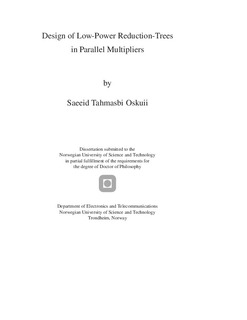| dc.description.abstract | Multiplications occur frequently in digital signal processing systems, communication systems, and other application specific integrated circuits. Multipliers, being relatively complex units, are deciding factors to the overall speed, area, and power consumption of digital computers. The diversity of application areas for multipliers and the ubiquity of multiplication in digital systems exhibit a variety of requirements for speed, area, power consumption, and other specifications. Traditionally, speed, area, and hardware resources have been the major design factors and concerns in digital design. However, the design paradigm shift over the past decade has entered dynamic power and static power into play as well.
In many situations, the overall performance of a system is decided by the speed of its multiplier. In this thesis, parallel multipliers are addressed because of their speed superiority. Parallel multipliers are combinational circuits and can be subject to any standard combinational logic optimization. However, the complex structure of the multipliers imposes a number of difficulties for the electronic design automation (EDA) tools, as they simply cannot consider the multipliers as a whole; i.e., EDA tools have to limit the optimizations to a small portion of the circuit and perform logic optimizations. On the other hand, multipliers are arithmetic circuits and considering arithmetic relations in the structure of multipliers can be extremely useful and can result in better optimization results. The different structures obtained using the different arithmetically equivalent solutions, have the same functionality but exhibit different temporal and physical behavior. The arithmetic equivalencies are used earlier mainly to optimize for area, speed and hardware resources.
In this thesis a design methodology is proposed for reducing dynamic and static power dissipation in parallel multiplier partial product reduction tree. Basically, using the information about the input pattern that is going to be applied to the multiplier (such as static probabilities and spatiotemporal correlations), the reduction tree is optimized. The optimization is obtained by selecting the power efficient configurations by searching among the permutations of partial products for each reduction stage. Probabilistic power estimation methods are introduced for leakage and dynamic power estimations. These estimations are used to lead the optimizers to minimum power consumption. Optimization methods, utilizing the arithmetic equivalencies in the partial product reduction trees, are proposed in order to reduce the dynamic power, static power, or total power which is a combination of dynamic and static power. The energy saving is achieved without any noticeable area or speed overhead compared to random reduction trees. The optimization algorithms are extended to include spatiotemporal correlations between primary inputs. As another extension to the optimization algorithms, the cost function is considered as a weighted sum of dynamic power and static power. This can be extended further to contain speed merits and interconnection power. Through a number of experiments the effectiveness of the optimization methods are shown. The average number of transitions obtained from simulation is reduced significantly (up to 35% in some cases) using the proposed optimizations.
The proposed methods are in general applicable on arbitrary multi-operand adder trees. As an example, the optimization is applied to the summation tree of a class of elementary function generators which is implemented using summation of weighted bit-products. Accurate transistor-level power estimations show up to 25% reduction in dynamic power compared to the original designs.
Power estimation is an important step of the optimization algorithm. A probabilistic gate-level power estimator is developed which uses a novel set of simple waveforms as its kernel. The transition density of each circuit node is estimated. This power estimator allows to utilize a global glitch filtering technique that can model the removal of glitches in more detail. It produces error free estimates for tree structured circuits. For circuits with reconvergent fanout, experimental results using the ISCAS85 benchmarks show that this method generally provides significantly better estimates of the transition density compared to previous techniques. | nb_NO |
